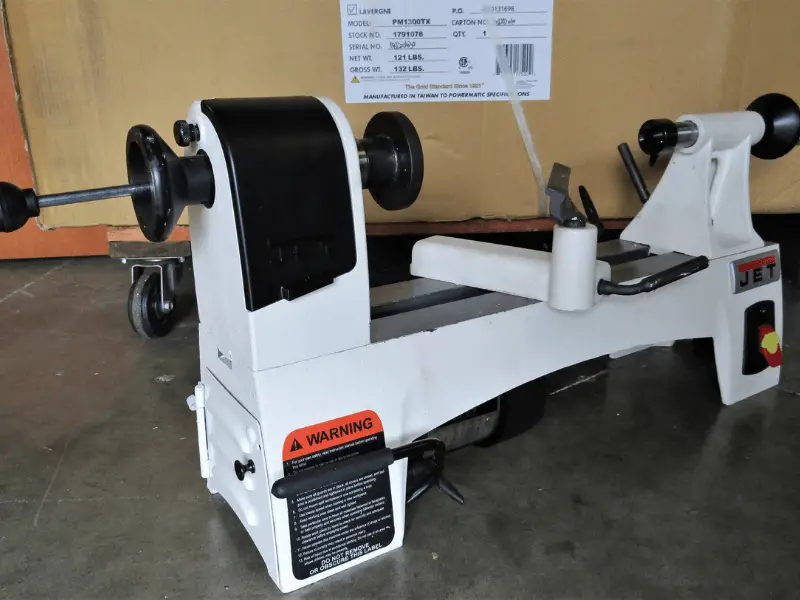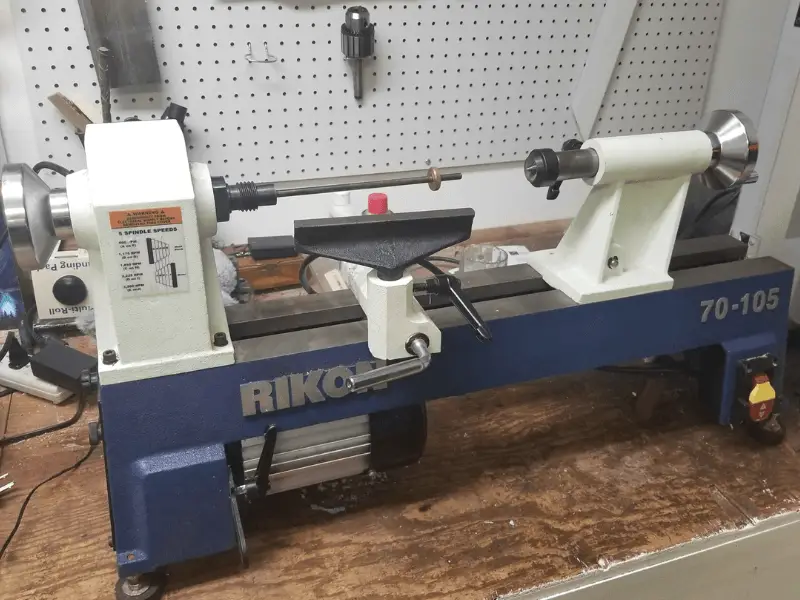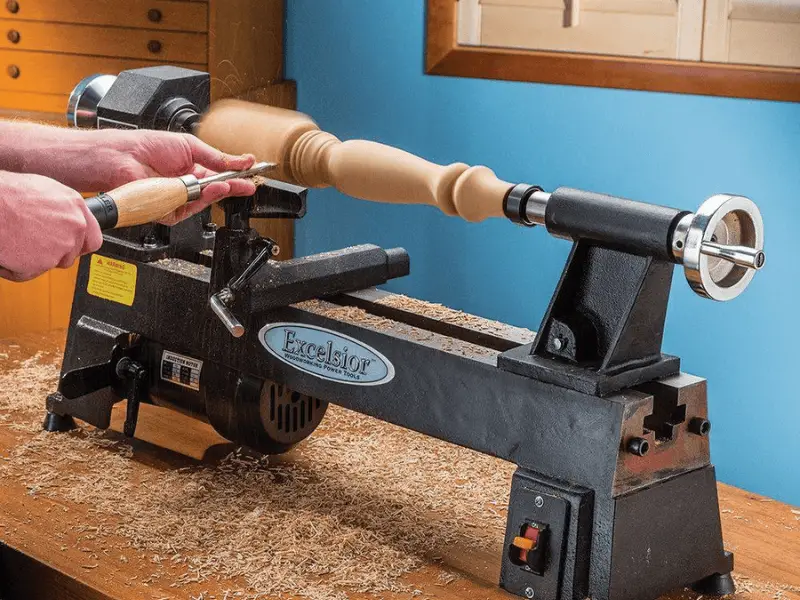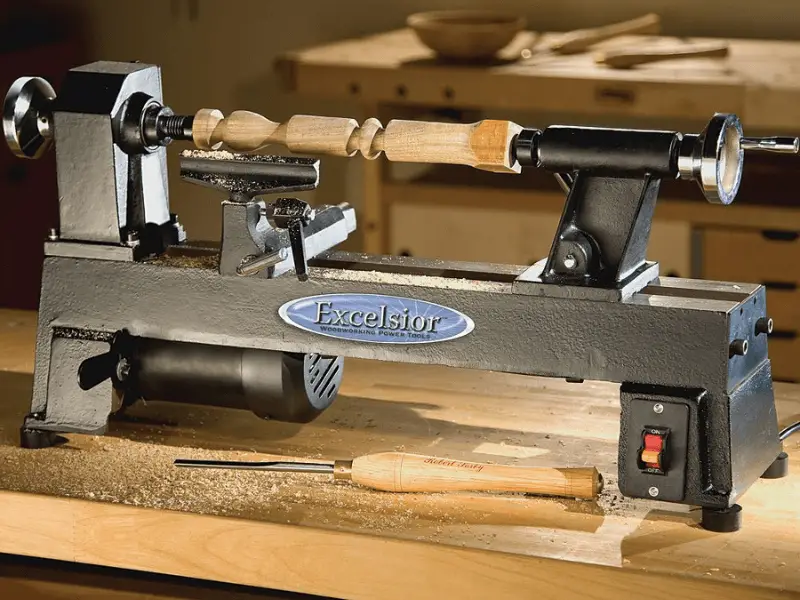For anyone looking to start turning their projects at home, one of the first things they’ll need to decide is which type of lathe to buy. There are many different choices out there, and while you might think they’re all the same and just differentiated by size, that’s not exactly true. Smaller lathes are easier to turn than larger ones, but they also have certain drawbacks and limitations that are important to remember before making your purchase.
However, finding the right one can be tough with many available options! This guide will give you all the information you need to choose the right mini wood lathe and begin your woodturning adventures!
In this guide, we have made choices according to factors such as brand, price, quality and performance, portability, and ease of usage.
Best Mini Wood Lathe for your next project- Our Top Pick
Here is a taste of what we will be discussing today; the following are some of the best mini wood lathes that have been voted the best mini-lathes on the market.
- Jet JWL-1015 10×15 Wood Lathe – Our top pick
- RIKON Power Tools 70-105 – Best for small spaces
- SHOP FOX W1704– Best Budget lathe
- Excelsior Mini Lathe– Ideal for heavy-duty applications.
- Central Machinery 7 x 10 Precision Mini Lathe
Best Mini Wood – Review
1. Jet JWL-1015 10×15 Wood Lathe– Our top pick
The Jet JWL-1015 is one of the best mini wood lathes for beginners looking to start turning several projects but with limited space in their workshop. It’s very easy to use and has many features that other mini lathes don’t. It’s also very affordable, making it a great option for starting.

Main Features
- The Jet JWL-1015 10×15 wood lathe is a great option for those looking for a powerful and versatile mini wood lathe.
- It’s also cast iron, giving it a strong frame that will last you for years.
- This lathe comes mostly assembled, except for the spur centre. The tool rest and knockout rod are typically disassembled but come with a simple, self-explanatory manual book for easy assembly. Simply set up the machine and get started turning your next project!
- It has a six-spindle speed that ranges from 500 -3975 rpm.
- The 15-1/2 inch distance between the headstock and the tailstock allows you to turn a large piece of wood. It also has an optional bed extension feature if you want to turn a large piece of wood.
- It has a 10 inches swing over the bed, allowing for quite a reasonable wood diameter.
- With a 1/2 HP single-phase motor, this lathe is powerful enough to handle a variety of different projects at ease without it becoming hot.
If you’re not sure what you want in a mini wood lathe yet, this model has the power you need while still being small enough to store easily on your desk or workspace.
Overall performance
The Jet JWL-1015 is a great mini wood lathe for beginners. It’s very user-friendly and has many features that make it perfect for those just starting. The only downside is that it’s a bit pricey. However, its overall performance is worth the price tag, and most say they’ve been very satisfied with their purchase.
RIKON Power Tools 70-105 – Best for small spaces
If you are a pen-turner looking for a solidly built, dedicated machine for your craft, the Rikon Power Tools 70-105 is an excellent choice. It has all the features that would make this lathe simple and long-lasting. This fantastic little lathe will impress you with its power, efficiency, and comfort. The spindle runs smoothly, so it’ll be easy to get some good quality work done.

main features
- It has a powerful ½ Hp induction motor, providing ample power for all turning needs.
- With a 10” swing and 18” between centres, this wood lathe will allow you to turn a large piece of the log but with a reasonable diameter.
- It is made of cast iron-Its sturdy construction ensures smooth turning with no vibration or wobbling!
- The pulley system has five positions, giving you a good range of speeds for almost any project.
- When you adjust the speed range, you can bore barrel holes, rough out pen billets, turn to shape, and finish.
- It also includes a live centre,6-inch tool rest, knock-out bar, 3-inch face plate, and wrenches.
Some of the weaknesses
- The speed change of the pulley belt was a little slow, but that isn’t a big deal in a home shop.
- You will be limited to using a big wood with a wider diameter, say 11 inches.
Overall performance
RIKON’s mini wood lathe is one of the best on the market for beginners, especially those who have limited space in their shop. It’s easy to use and has great overall performance. Plus, it comes with a five-year warranty, so you can be sure it will last.
SHOP FOX W1704 – Best Budget lathe
The SHOP FOX W1704 is one of the best mini wood lathes on a tight budget for beginners. It’s easy to use and has various features that make it perfect for learning how to lathe. Plus, it’s affordable and comes with a two-year warranty. If you’re looking for an awesome beginner lathe, this is it!

Main Features
- The Cast iron construction makes this machine sturdy and reliable while keeping the weight down so that it’s easier to move around if necessary.
- The headstock offers four speeds from 700 RPM up to 3200 RPM, which means you can work on everything from turning small pen blanks on low speed up to turning large bowls at high speed.
- It has a 12-inch capacity and 8-inch swing over the bed, which is quite a good size for turning medium-sized wood blanks.
- The headstock spindle of this benchtop lathe has a 5-3/4-inch faceplate that threads onto it for non-spindle turning, typically done to create bowls or other objects that the tailstock cannot support.
- It has two tool rest, one of 4-1/2 and the other of 7-inch. The two tools rest are interchangeably used for various turning applications.
- This lathe also has a powerful 1/3 HP, 2 Amp, 110V, Single-phase motor that provides enough power required for turning various projects.
Some of the weaknesses
- Unfortunately, the 1/3 horsepower motor may not be powerful enough for some projects.
- The lathe only comes with a 5-inch faceplate, so you may need to purchase an additional one if you want to use larger turning tools.
Overall performance
its overall performance is impressive, making it a great value for the money. This will be your perfect lathe to consider if you are just starting, especially in turning smaller items such as rings or bowls.
This wood lathe is among the cheapest on our list of the best wood lathes under $500, which I recommend you read if you are on a tight budget.
Excelsior Mini Lathe– Ideal for heavy-duty applications.
If you need a heavy-duty mini lathe that is powerful enough to handle your small turning project, look no further than the Excelsior mini-lathe. It’s lightweight and simple to use.

Main Features
- The lathe has five different speed settings, so you can find the perfect speed for your project.
- The speed ranges from 760 up to 3200 Rpm.
- It is easy to change speed. You must release the motor tension and set the belt to the speed desired on the motor and spindle pulleys.
- It has a 1/2 Hp induction motor that is powerful enough for all your turning projects.
- It has a knockout bar, drive centre, and face plate for bowl turning.
- It can turn bowls nearly 10 inches in diameter and spindle up to 71-3/4 inches long.
- To switch to bowl turning, tap the drive centre with a knockout bar and screw the face plate onto the headstock.
- The cast iron construction will stand up to years of use without breaking.
- This mini lathe can accept optional bed extension, increasing the spindle capacity to 38-1/2 inches.
Some of the weaknesses
- The Excelsior is not as powerful as some of the other mini wood lathes on the market.
- The bed extension with the lathe is not very sturdy and can wobble if you’re not careful.
- Though the motor provides adequate power, it will bog down(be unable to progress) after prolonged use.
Overall performance
Overall, It’s a great machine that will help you get started with woodturning, and it has plenty of features that make it easy to use. The five-speed settings are easy to change, and the motor is powerful enough to handle most projects. The bed is also adjustable, so you can turn different-sized pieces of wood. If you’re just starting woodturning, this is an excellent choice!
Factors To Consider When Choosing A Mini Lathe
When it comes to woodturning, the most important tool you’ll need is a lathe. But with so many types and sizes of lathes on the market, it can be tough to know which one is right for you. Here are a few things to consider when choosing a mini wood lathe:
1. What type of projects do you want to make?
Many people prefer turning bowls, spindles, pen blanks, or other small objects; therefore, if you only require a lathe for small projects, consider purchasing a mini lathe that will serve you well. A smaller lathe will be more suited for smaller projects, while a larger one can handle bigger pieces.
The type of wood you also use significantly affects the type of turning. As a result, I highly recommend this article on the Best Woods for Turning.
2. The lathe capacity
The lathe capacity will determine the maximum size of the project. It consists of the swing and distance between centres. The lathe’s swing is the distance between the headstock spindle and the bed: It limits the diameter of the wood blank you can mount to the headstock over the lathe bed. The swing for many mini-lathe generally ranges from 5-12inches.
The maximum length of the work you can turn is determined by the distance between the headstock driver spur centre to the tailstock centre when the tailstock is at its maximum distance from the headstock. The distance between centres for most mini-lathes generally ranges from 11-18 inches. Therefore if you want to turn large spindles than the maximum capacity, consider choosing a lathe that allows lathe bed extension.
3. Speed Adjustment feature: variable speed vs. multi-speed
The variable speed lathes are adjusted by turning the speed dial. They let you easily adjust the speed to meet the requirement of the project at hand. For instance, to drill a hole in a pen blank requires you to adjust to low speed, Sanding requires low speed and turning requires you to adjust to high speed. Variable speed lathes are best for beginners because they’re easy to use and offer more control.
The multi-speed lathes are hard to adjust rotation speed since they require you to open a compartment door and move the drive belt from pulley to pulley every time you want to adjust the speed. This makes them less convenient than variable speed lathes. However, multi-speed models are less expensive than their variable-speed counterparts.
Multi-speed lathes are best for experienced woodworkers because they offer more power and flexibility. However, this comes at the cost of being more difficult to operate. If you have experience using a drill press or benchtop drill, you should be able to learn how to operate a multi-speed lathe quickly. For those who don’t have experience with power tools, variable speed is a better option.
4. Space in your workshop
A mini wood lathe is a great solution for anyone who doesn’t have a lot of space to work with. These lathes are small and compact but still offer all the features and power you need to get started in woodturning.
5. How much money do you want to spend?
For beginners, it’s usually better to go with a less expensive option until you decide whether or not you like this hobby. For example, we recommend starting with the Mini Wood Lathe by LEARN-TO-TURN because they’re excellent quality but inexpensive enough that if they’re not what you were looking for, it won’t break the bank. It has all the features in a more expensive model (such as variable speed control) but at an entry-level price point.
How Much Should I Spend On A Mini Lathe?
Deciding how much to spend on a mini lathe is tricky. You don’t want to spend too little and end up with a machine that can’t handle the projects you want to make. But you also don’t want to spend too much and end up with a machine you’ll never use to its full potential.
Here’s a rough guide to help you decide what price range will suit your needs.
- Under $100, most machines will be underpowered and flimsy, but there are some exceptions if you do your research carefully.
- $100-$200, machines in this range are better quality than those in the under $100 category but still not great quality or power.
- $200-$400, these are typically good quality machines that have decent power and usually come with a stand or bench, which makes them worth it if you have limited space in your shop.
- $400-$600, these are high-quality machines can easily turn larger pieces of wood. They often come equipped with larger motors and heavier duty stands or benches.
- Lastly, over $600 is where things start getting ridiculous – if you’re just starting, I recommend staying away from this range unless you have the money to throw around carelessly.
FAQs About Mini Wood lathes
1. What can I make on a mini wood lathe?
A mini wood lathe can be used to create a variety of small wooden objects, such as bowls, pens, vases, and chess pieces. If you’re just starting, choosing a lathe that is easy to use and designed for beginners is important.
2. What are the benefits of using a mini wood lathe?
A mini wood lathe can be a great asset for any woodworker, especially beginners.
- They are small and compact, so they don’t take up a lot of space in your workshop.
- Plus, they are relatively inexpensive compared to full-size lathes.
- Mini wood lathes are also very versatile and can be used for various projects.
- And because it is lightweight, it’s easier to move around when you need to transport it or store it. Some even come with wheels!
The downside to these smaller lathes is that they typically have limited capacity and are not suited for heavy-duty work like cutting large pieces of lumber. Due to the slower speeds associated with mini wood lathes, it may take more time to make things.
However, this shouldn’t discourage anyone from considering one, as they can still get plenty done. If you’re looking for a machine that will give you many years of service without breaking the bank, then investing in a mini wood lathe could be just what you’re looking for.
3. Which Are The Best Brands Of A Mini Lathe?
If you’re looking for the best mini wood lathe, you’ll want to consider brands like Jet, Powermatic, and Delta. These lathes offer a variety of features that can be helpful for beginners, including adjustable speed settings and sturdy construction. With so many options on the market, it’s important to research to find the lathe that best suits your needs.
5. Can you make a bowl on a mini lathe?
You can make a bowl on a mini lathe, but it takes practice and patience. You first need to find a piece of wood that is the right size and shape. Then, you need to mark the centre of the wood and start turning the lathe on. Once the lathe runs, slowly start shaping the wood into a bowl. Keep checking the wood to see if it is in the desired shape. If not, turn off the lathe and adjust your speed or try a different type of cut. Practice makes perfect with this project, so don’t give up! It will take time before you can make bowls as easily as other projects.
6. What is the difference between a midi and mini lathe?
Midi lathes are larger and more powerful than mini-lathes, making them better suited for bigger projects. They also tend to be more expensive. On the other hand, Mini lathes are smaller and less powerful, making them better suited for smaller projects. They’re also usually more affordable, making them a good option for beginners.
7. What Type Of Lathe Do I Need?
Again, this question comes down to what you plan on making with your new tool. A mini lathe will work well if you only want to turn smaller items like pens or jewellery. But if you want to produce large bowls or furniture, then the best option would be an American-made midi lathe.
These are more expensive because they require more power, but the investment is worth it because they last for decades. There’s no need to worry about being stuck with a lesser machine that can’t cut as smoothly or quickly as you need it to.
The type of lathe you require is also influenced by the Wood Turning Tools you use. I recommend reading A Guide to Wood Turning Tools to grasp what I mean fully.
conclusions
If you’re looking for a mini wood lathe to help you get started in woodturning, any of the lathes on our list would be a great choice. Just be sure to research and pick the best suits your needs. And if you have any questions, don’t hesitate to ask an experienced woodturner for advice. They will be happy to help!
If you want more information about any of these products, look at their product page for reviews, customer comments, specs, and more details. But whatever mini wood lathe you choose, just remember this is an investment in your hobby or career, so make sure it’s right for you!
And if you have any questions or feedback about our list of the best mini wood lathes for beginners, feel free to leave them in the comments below.

